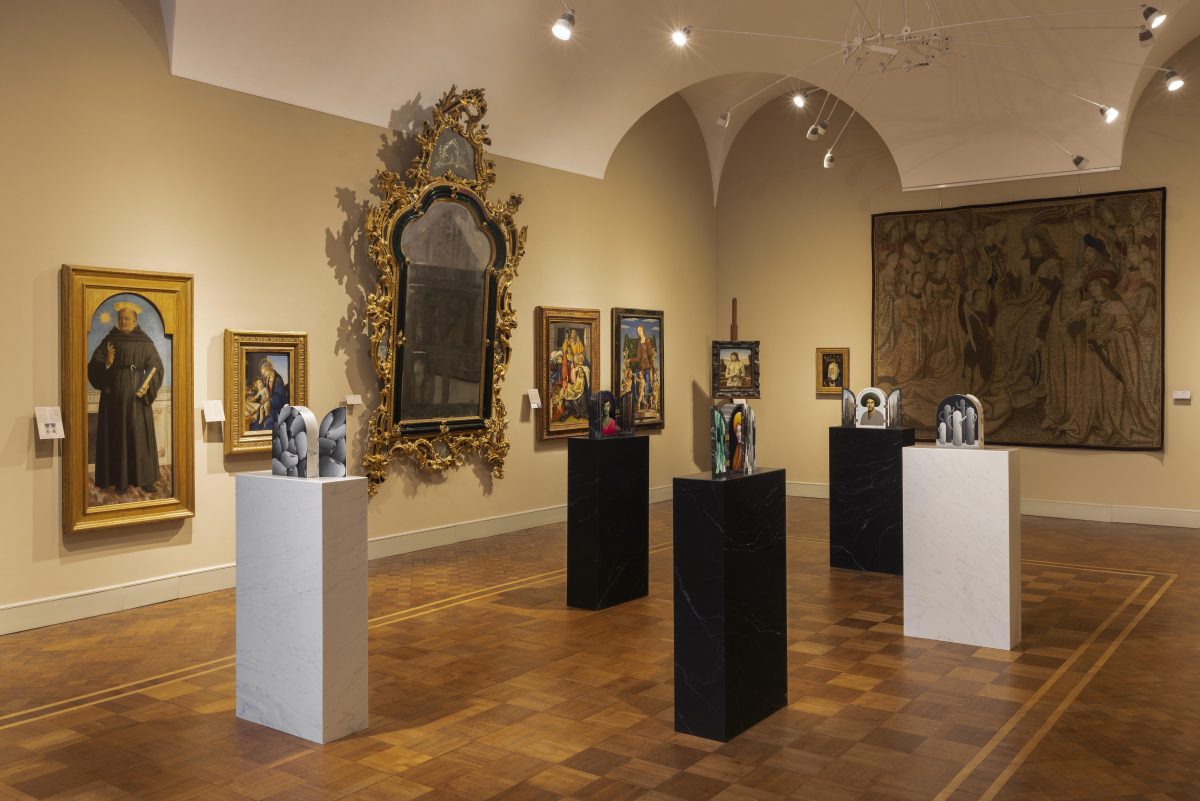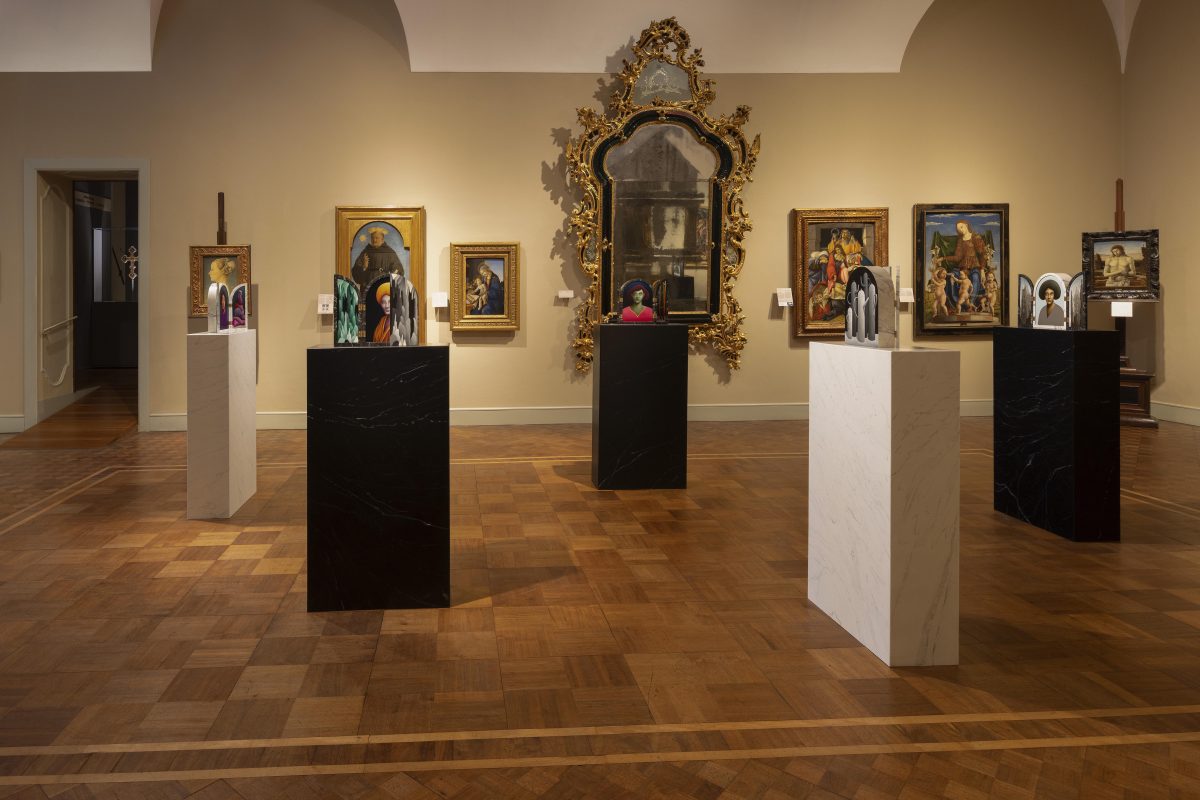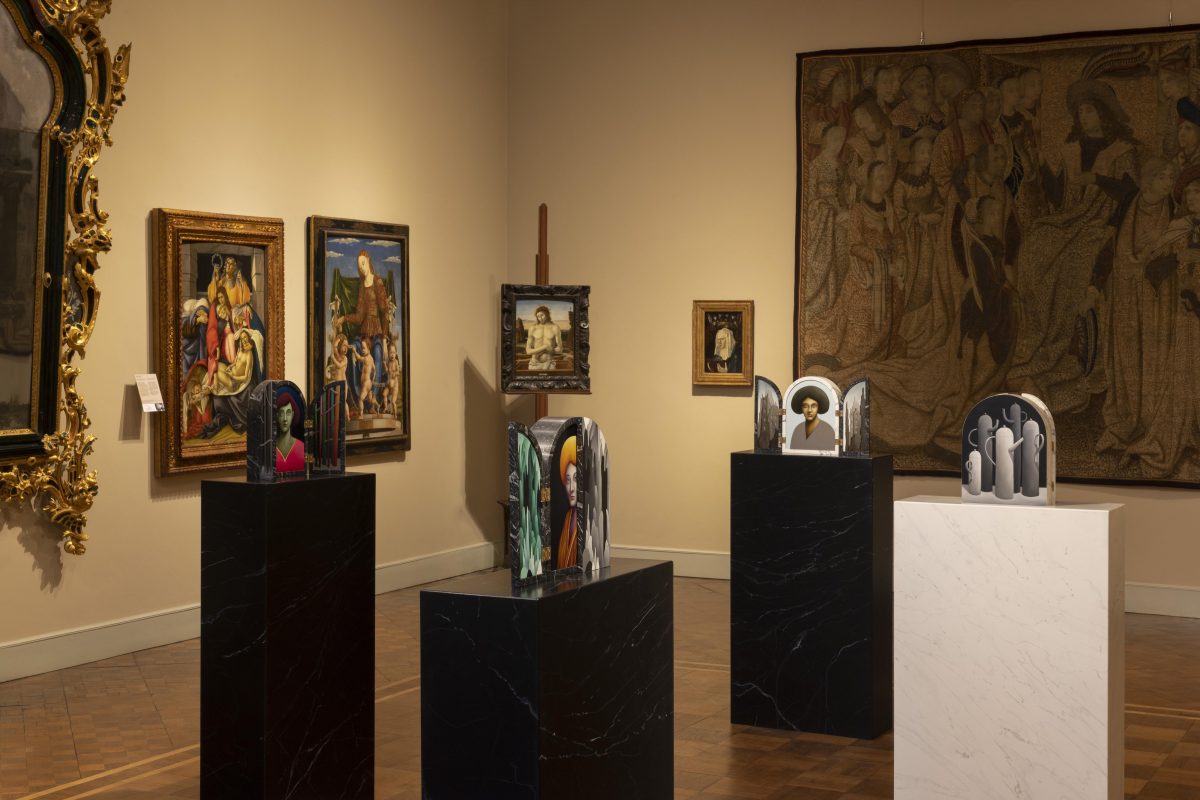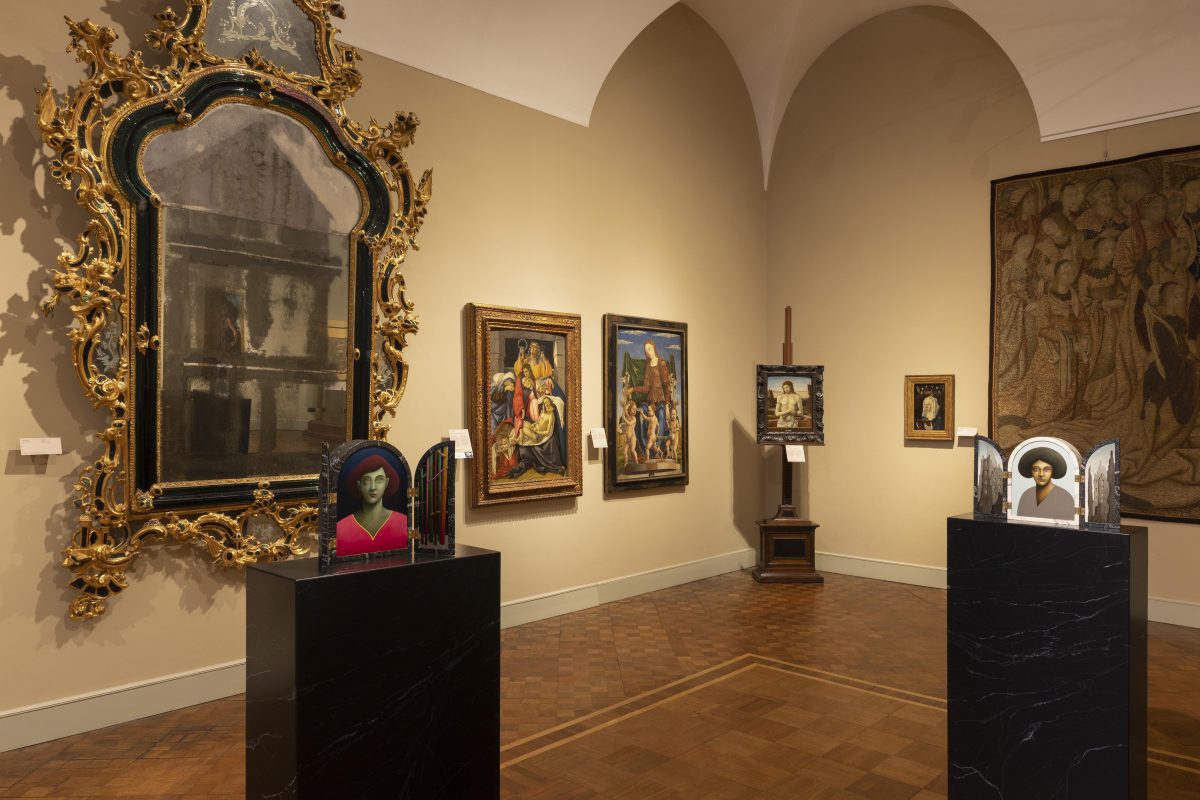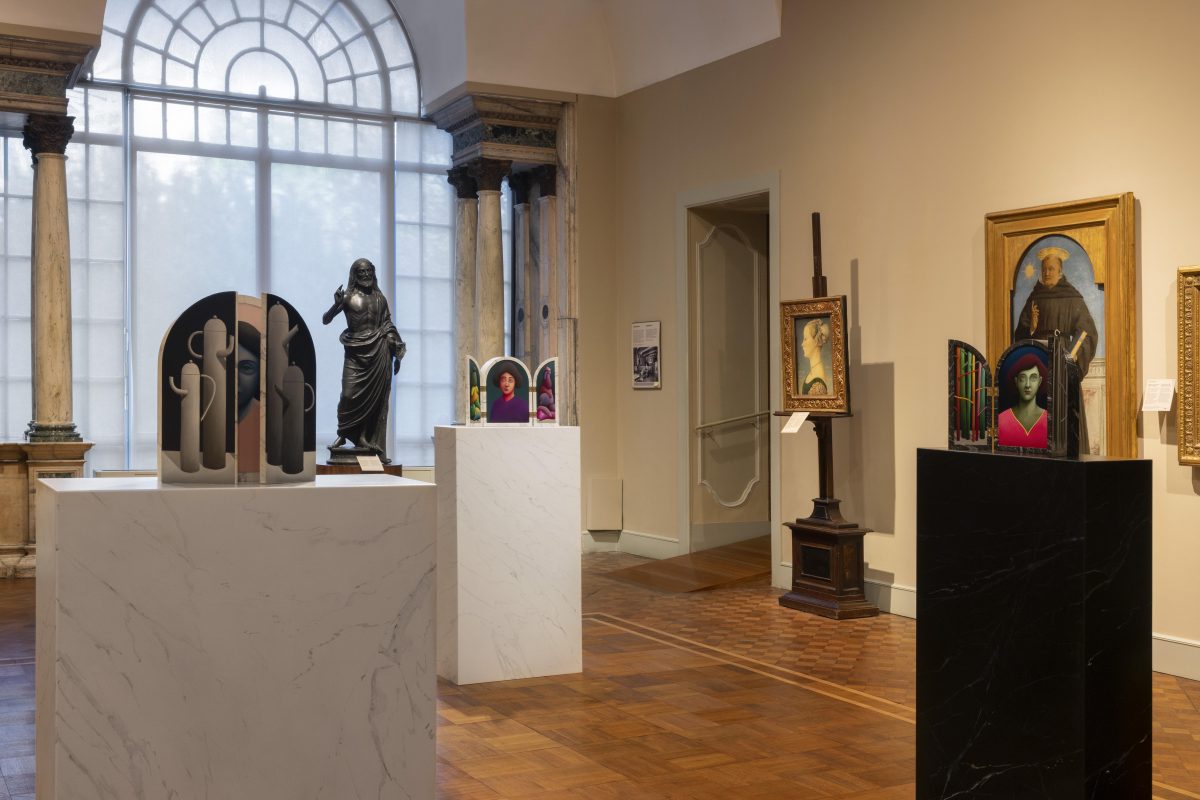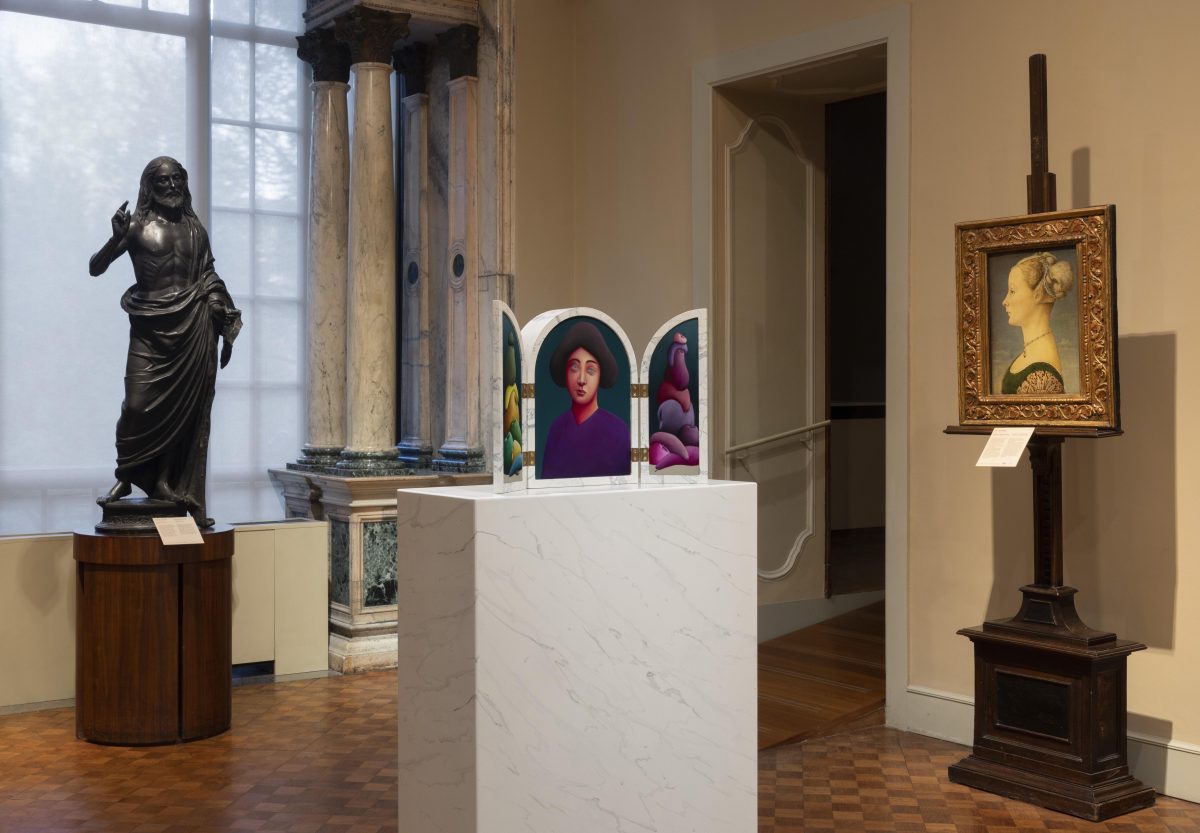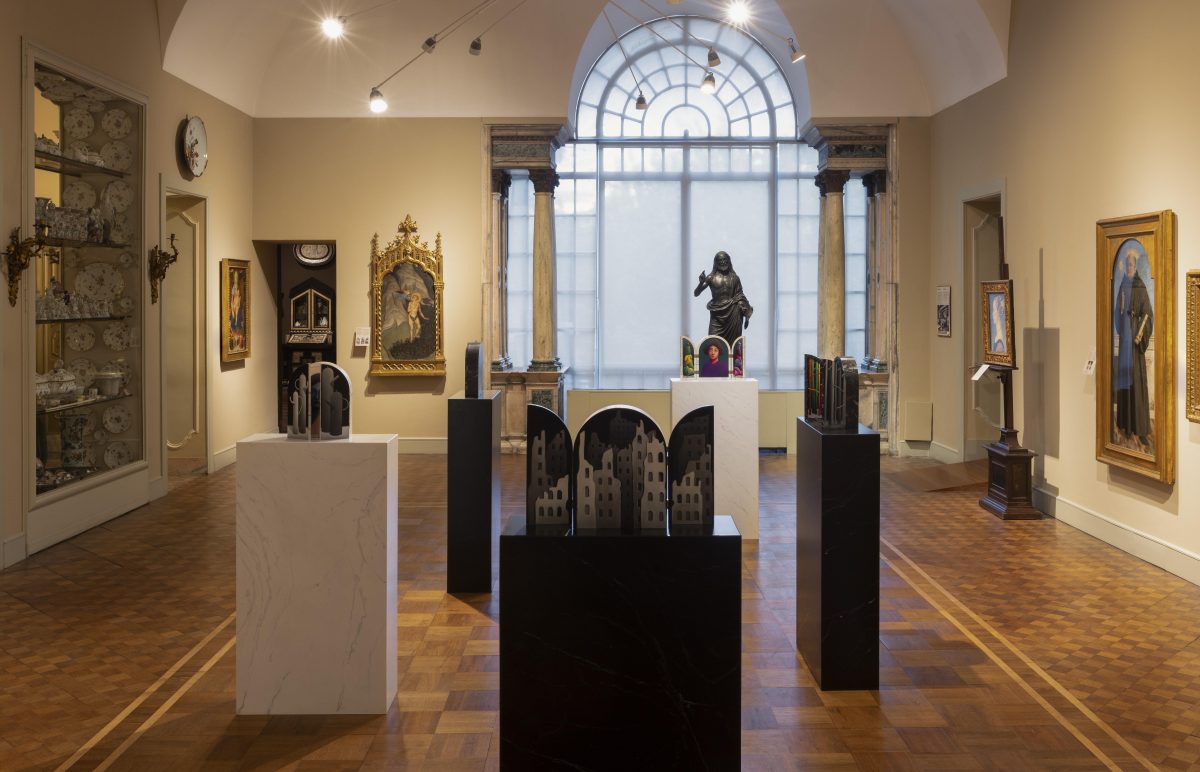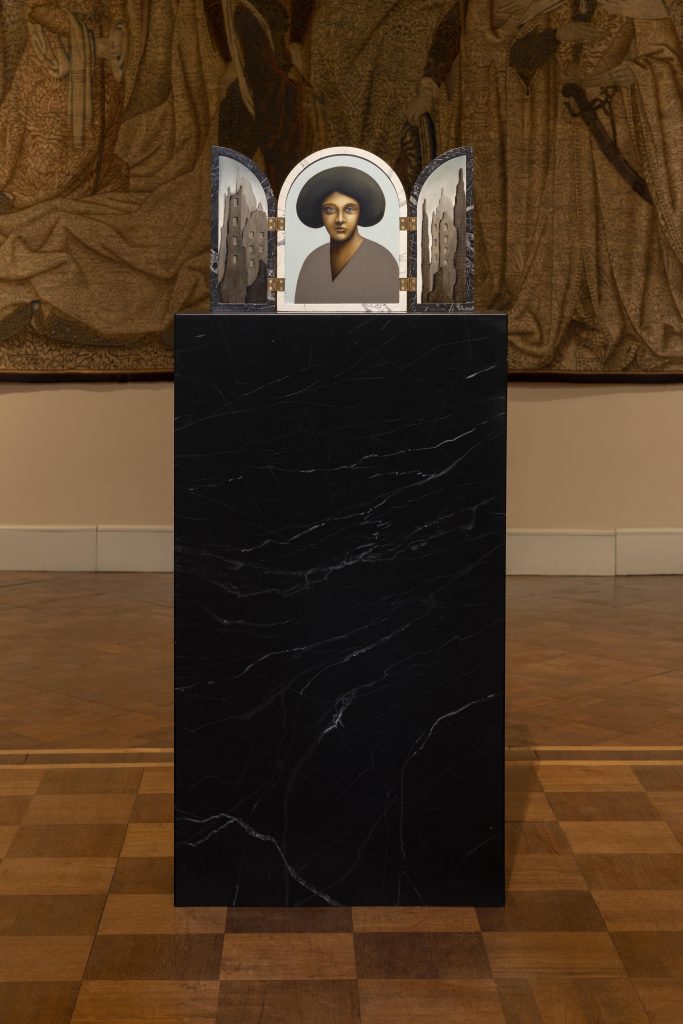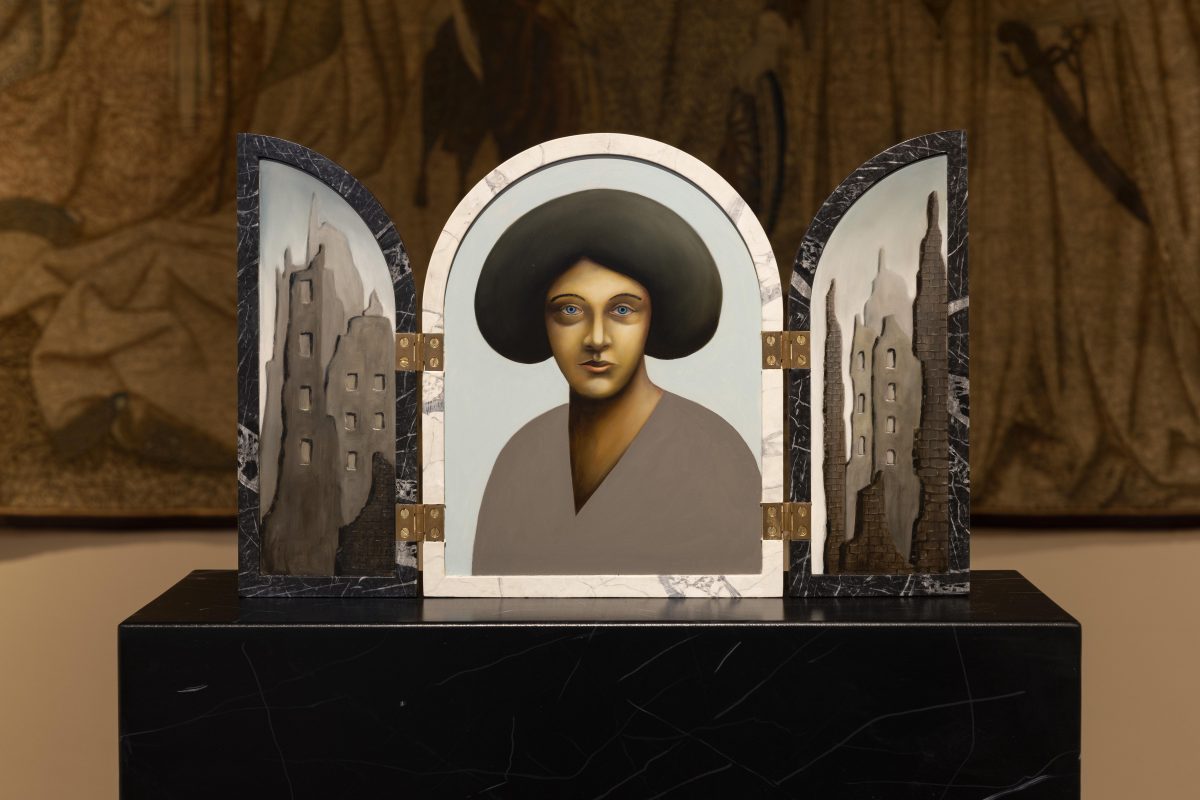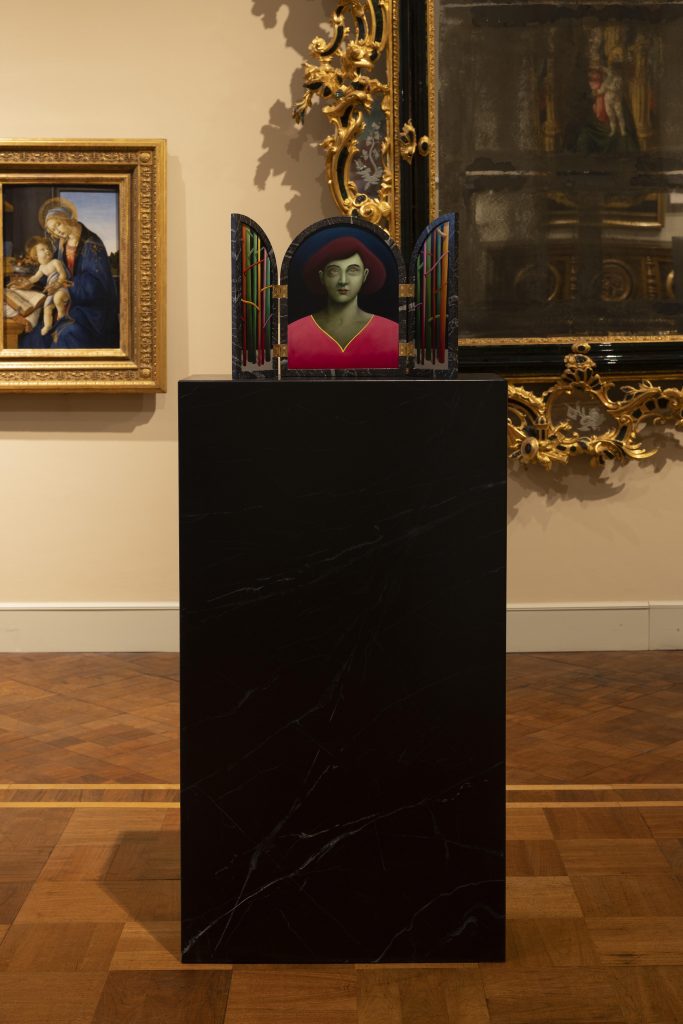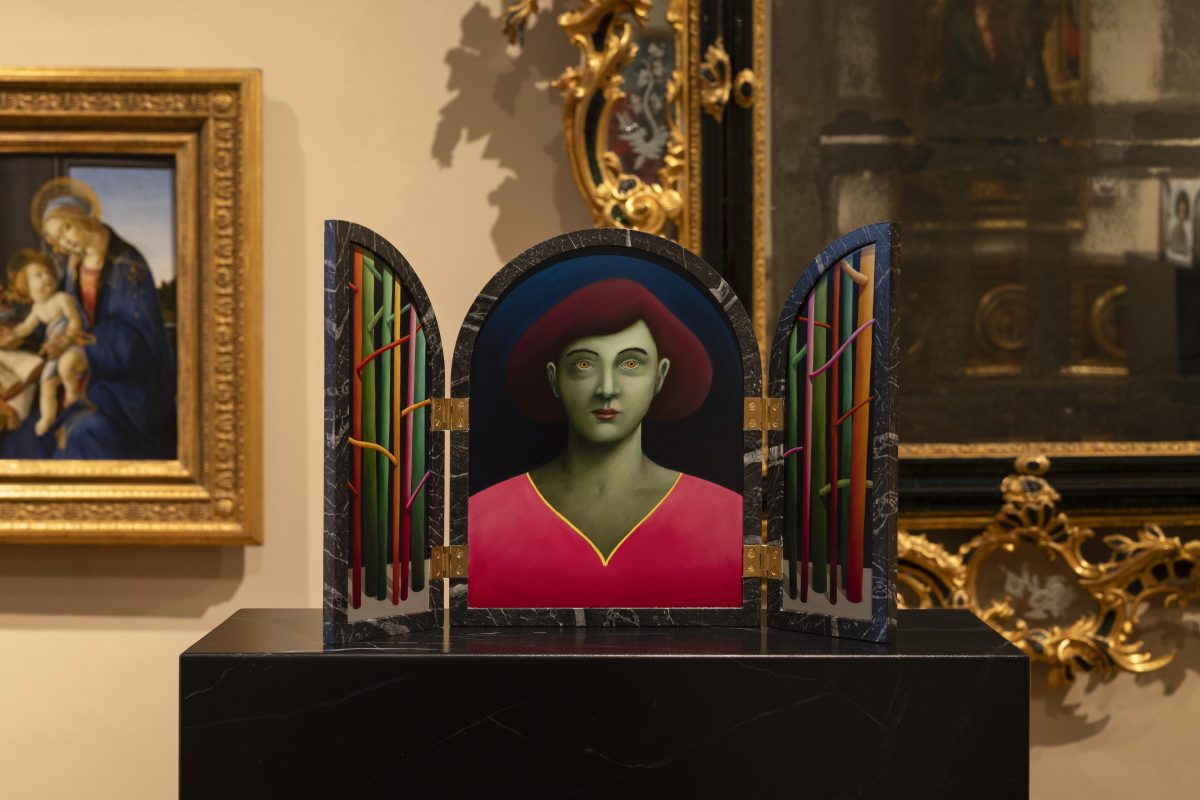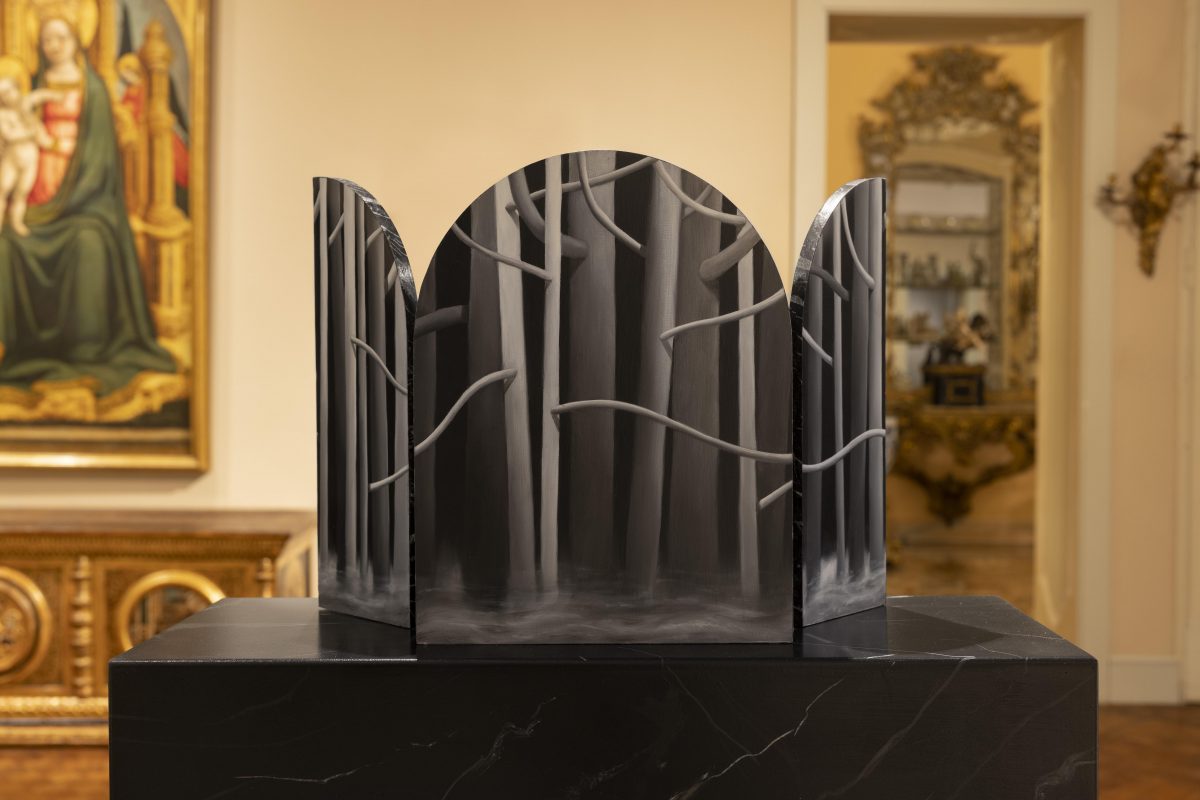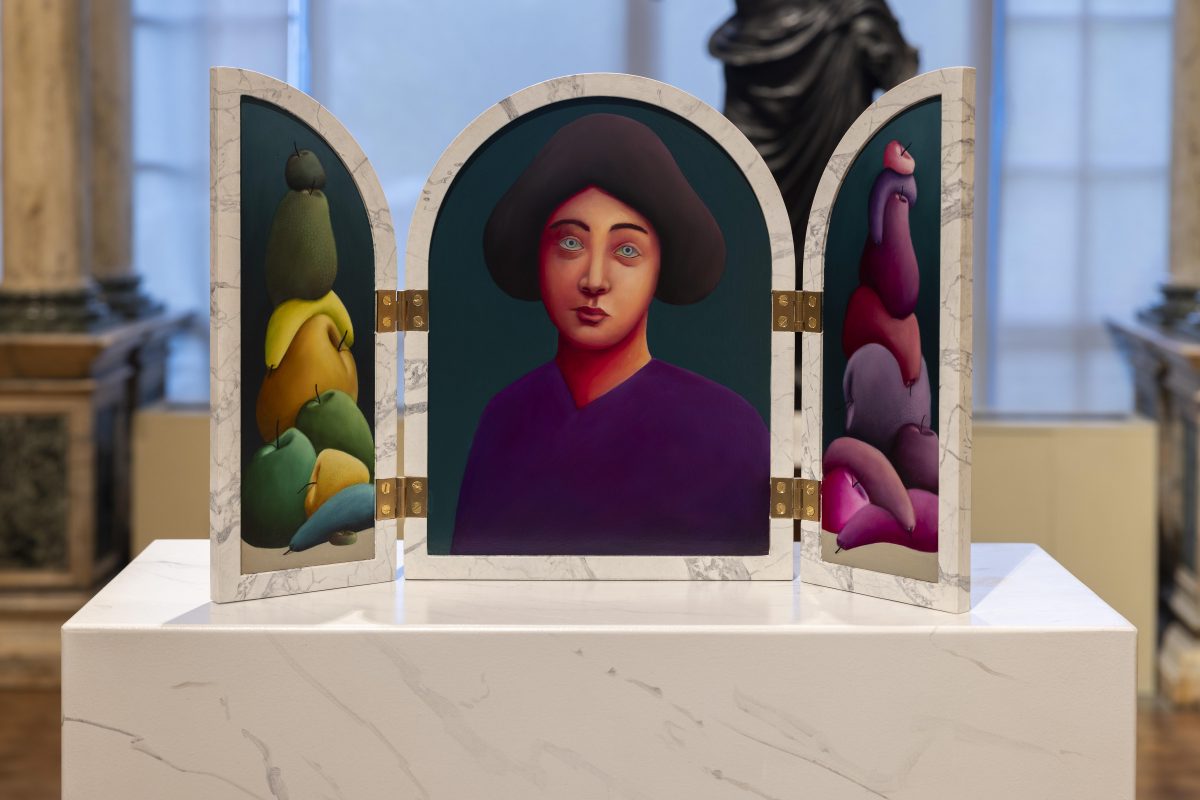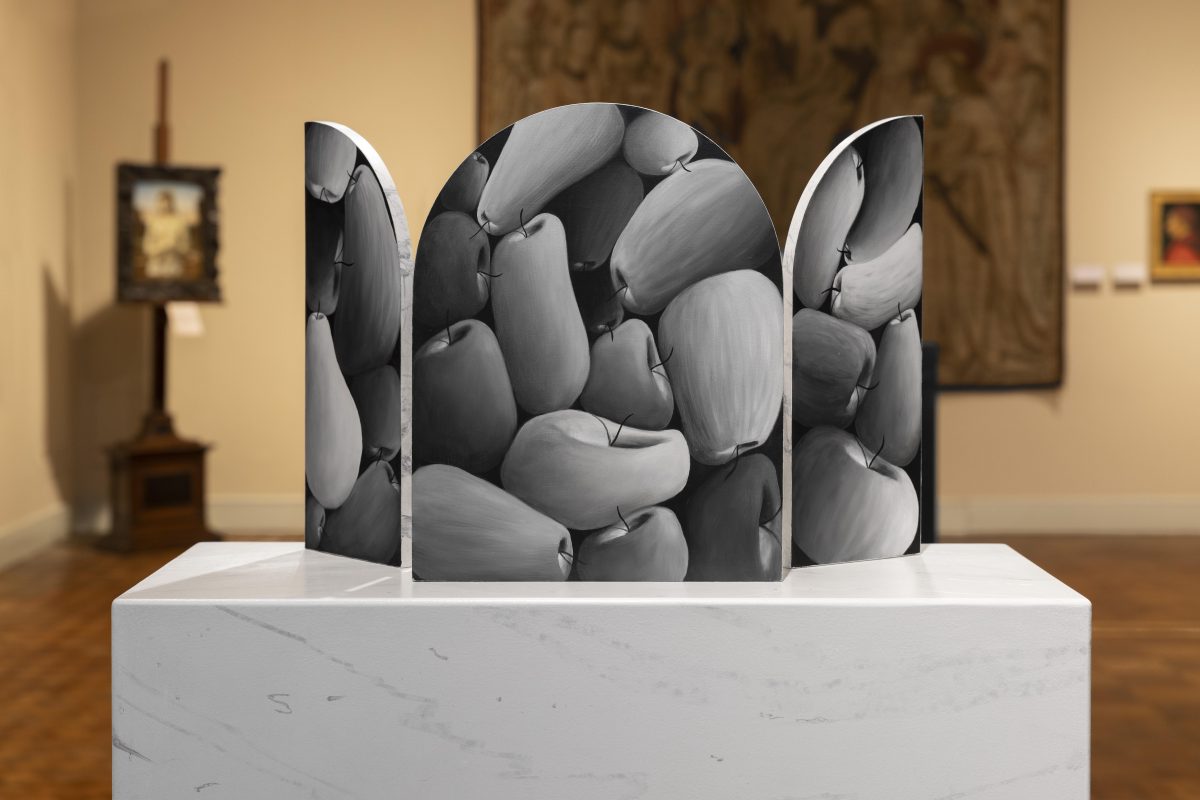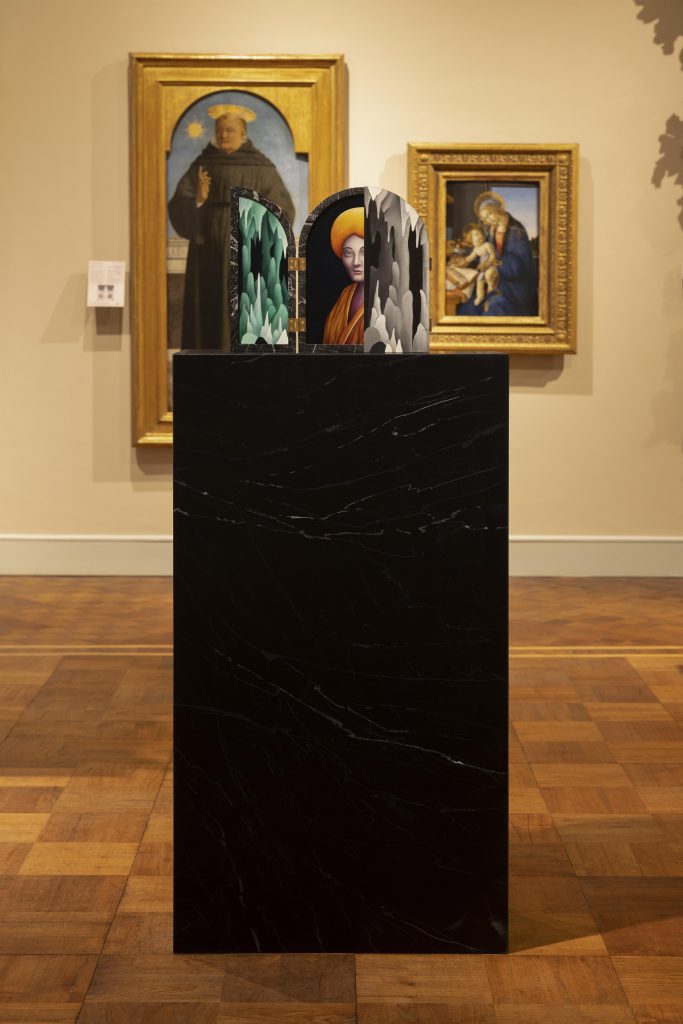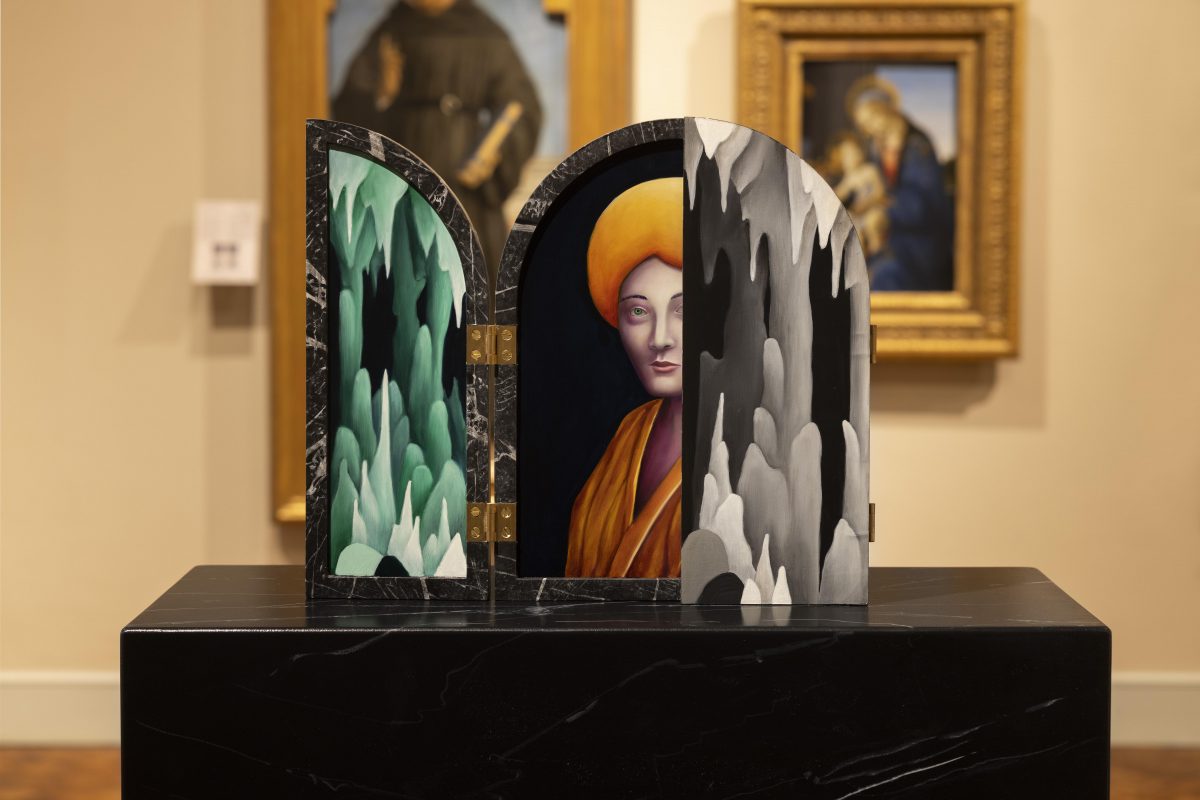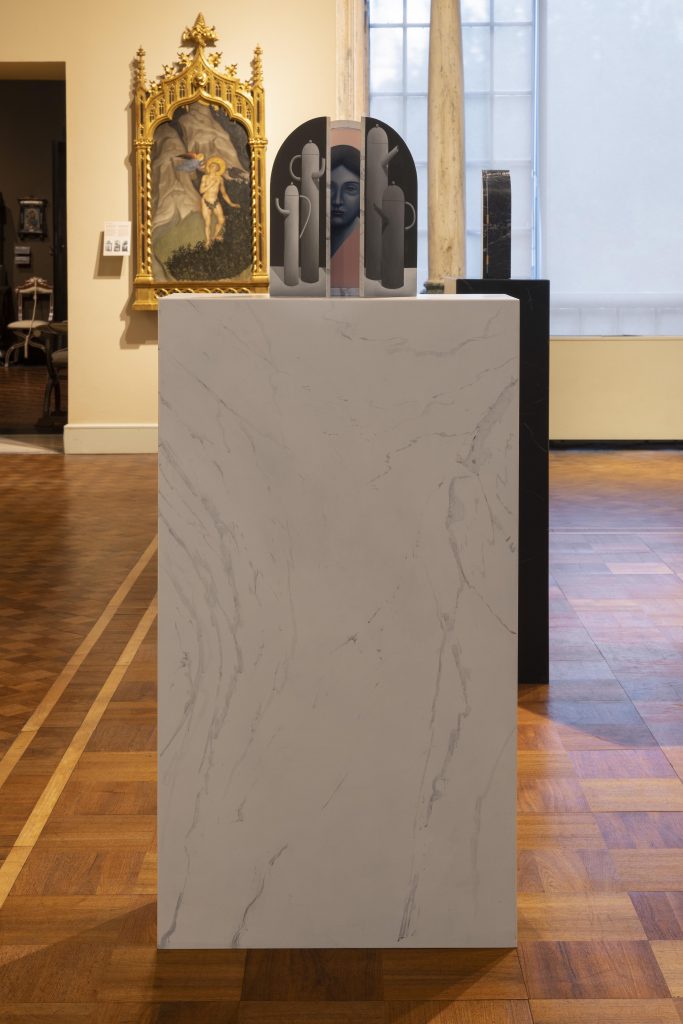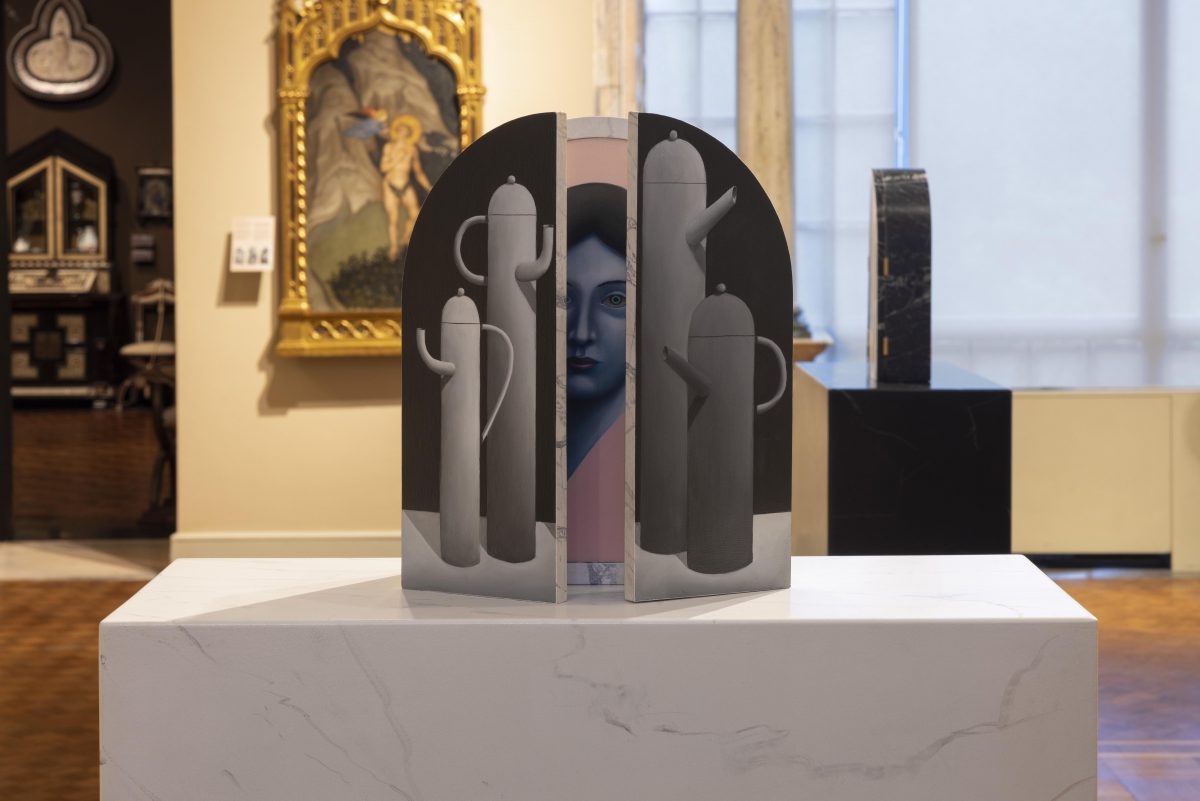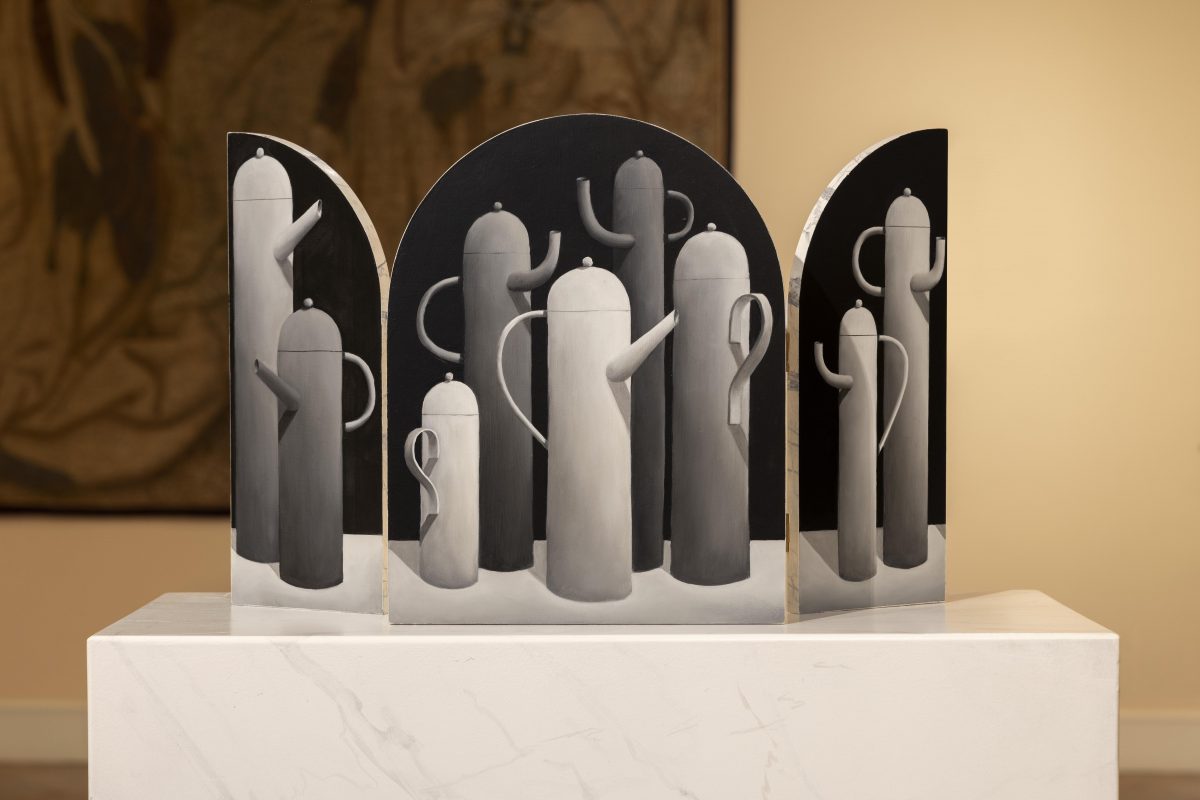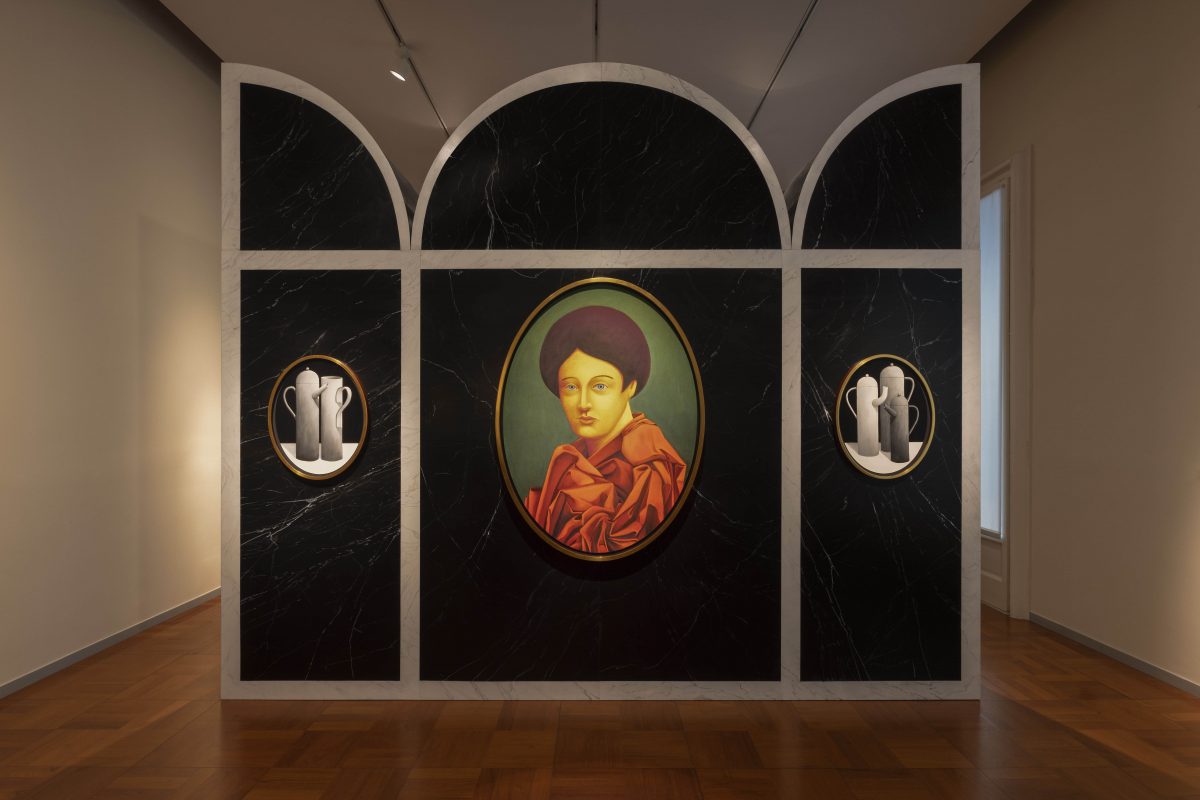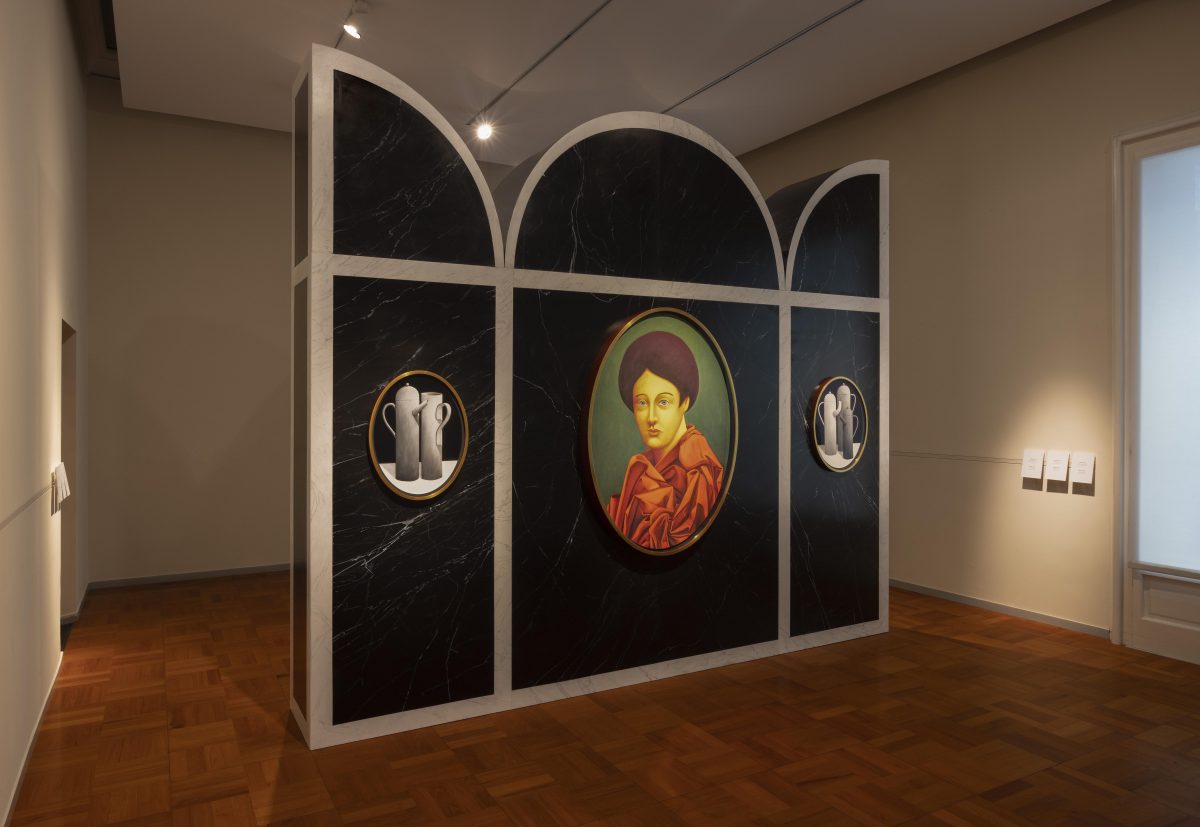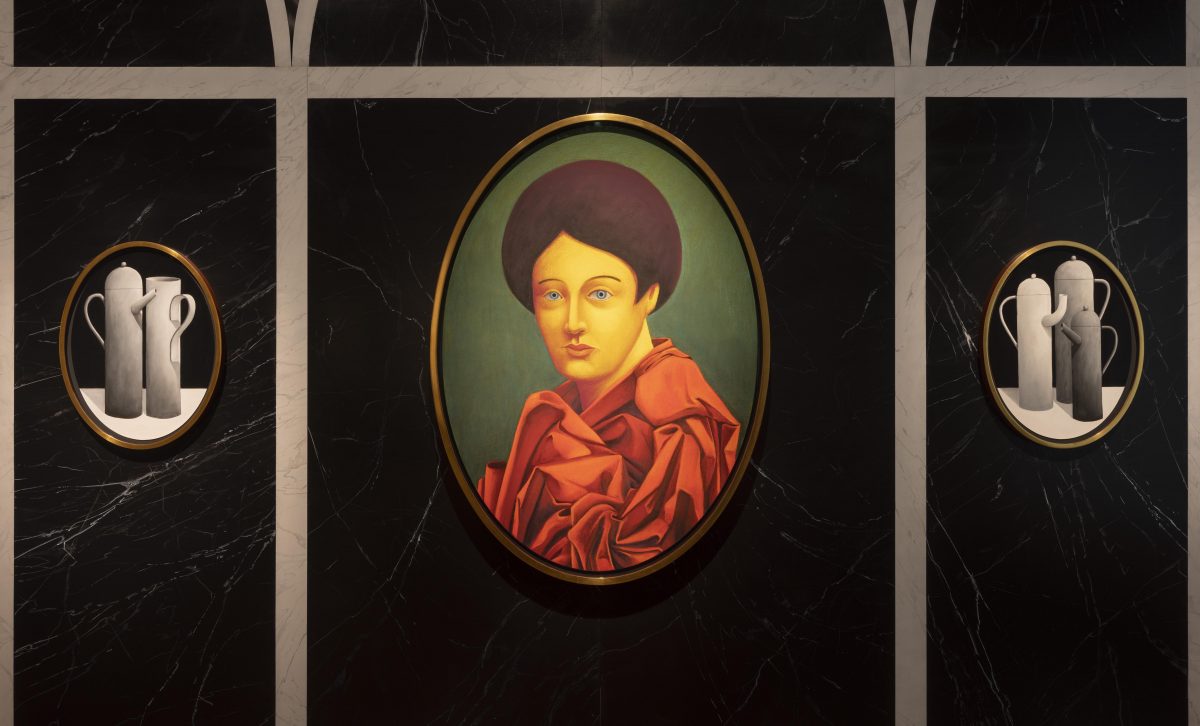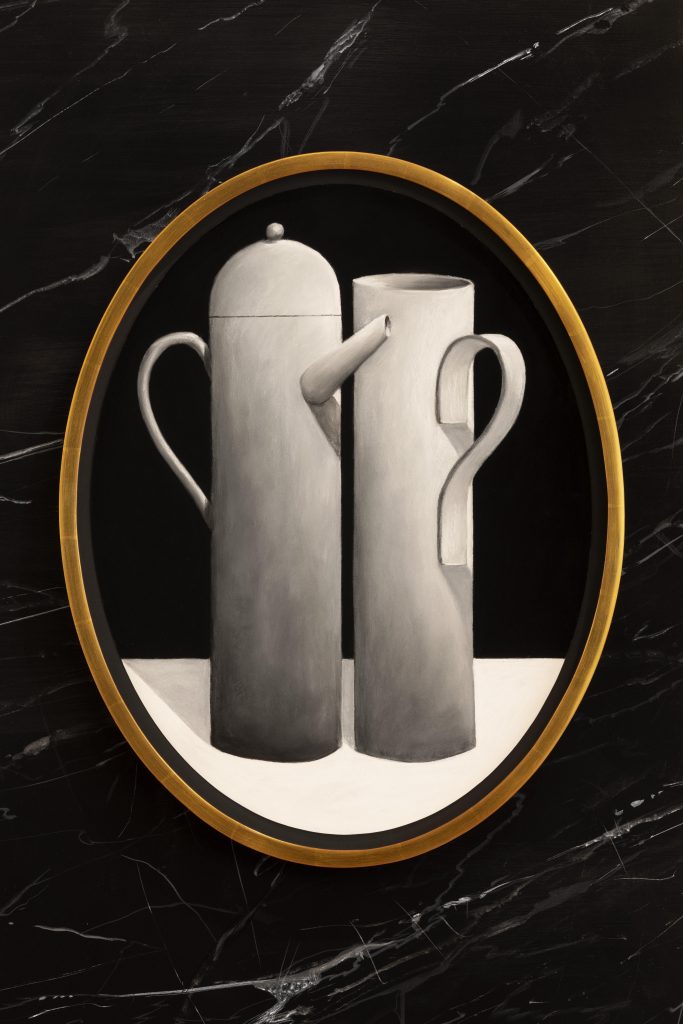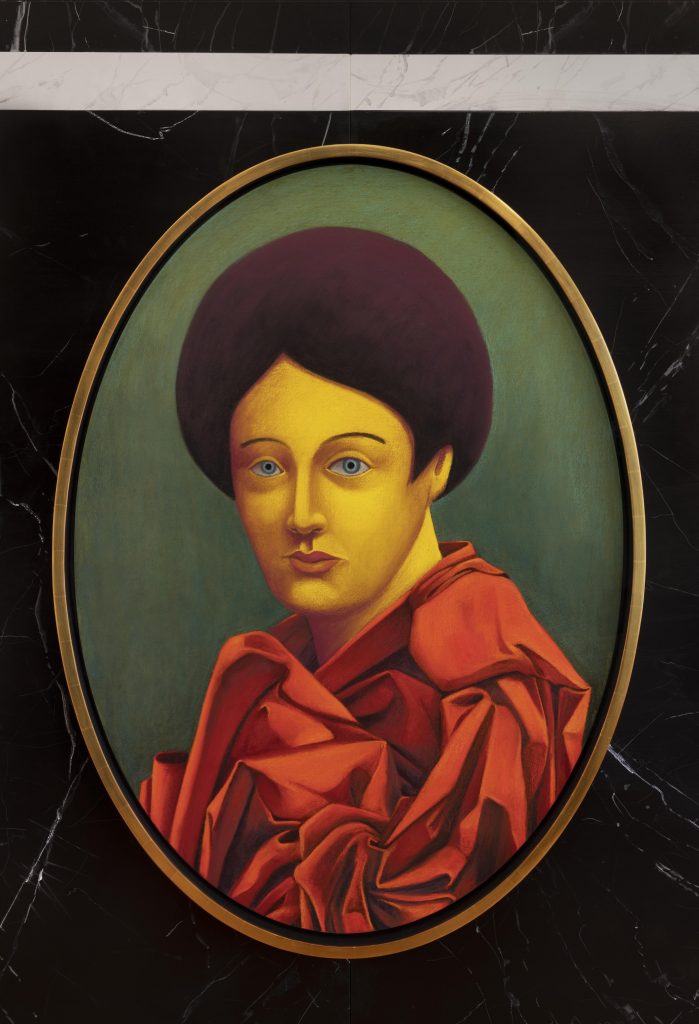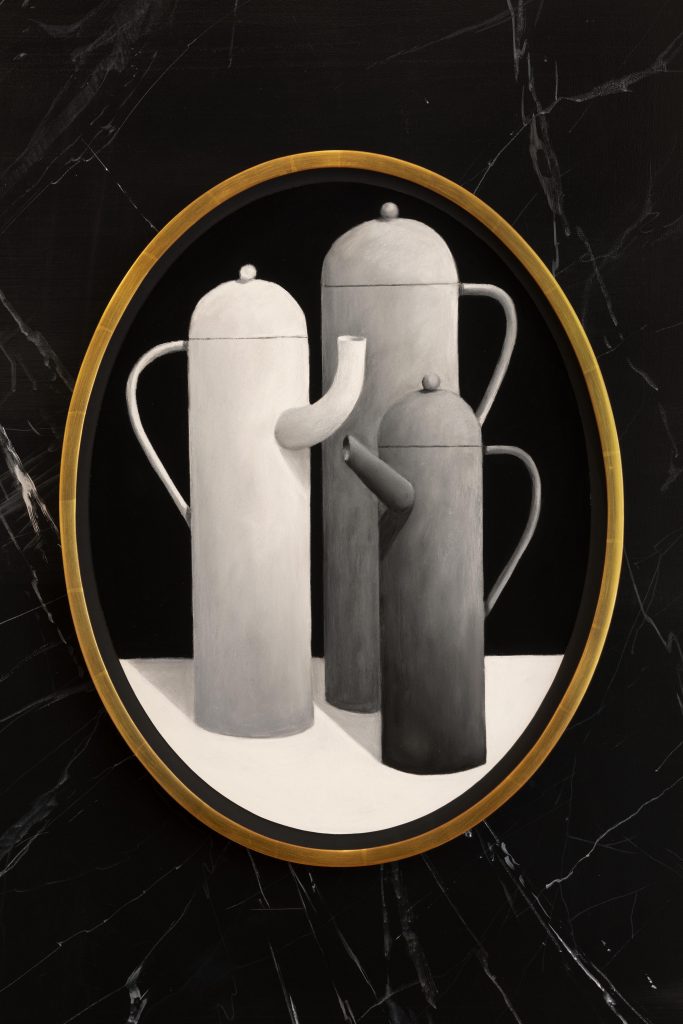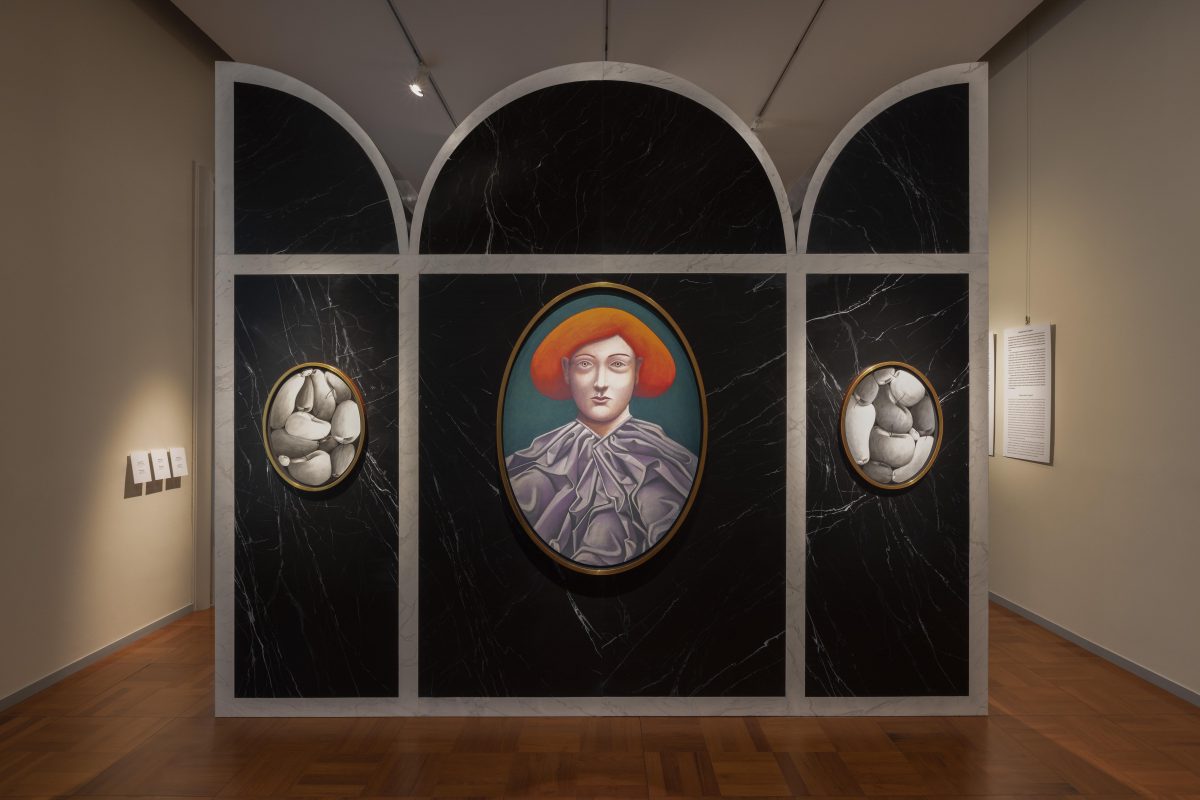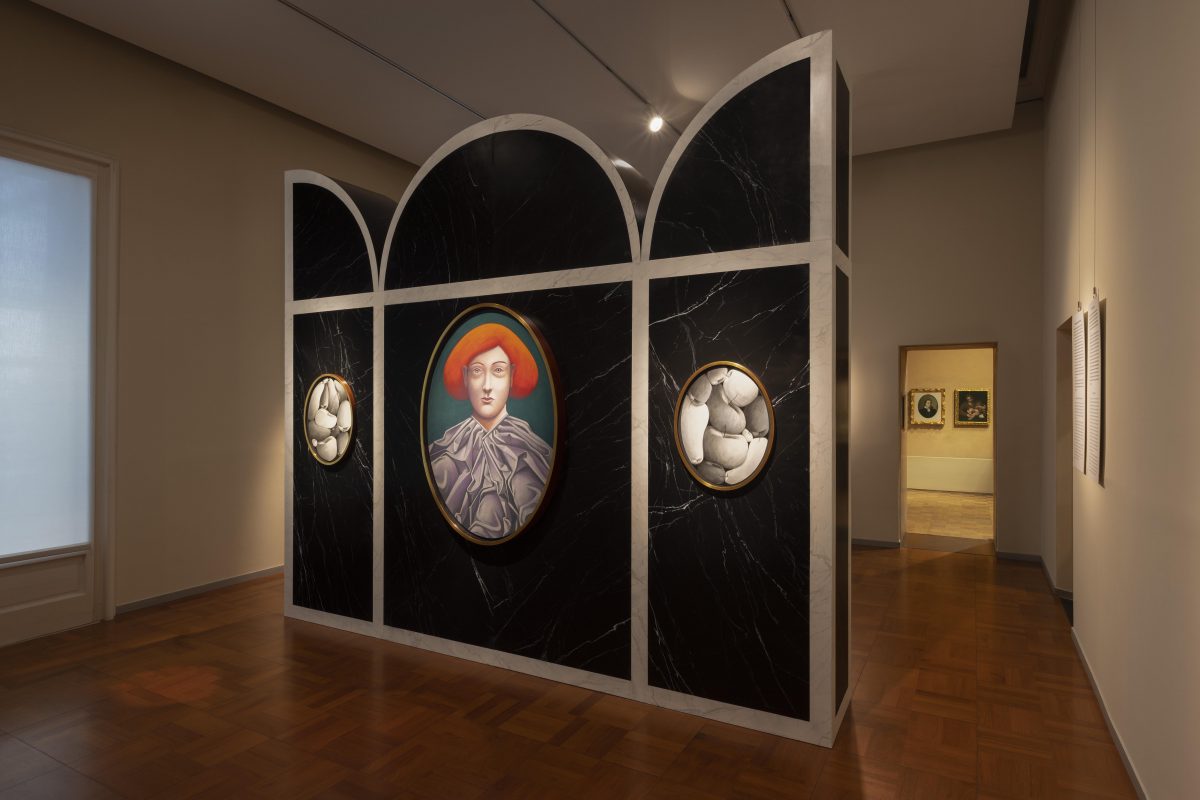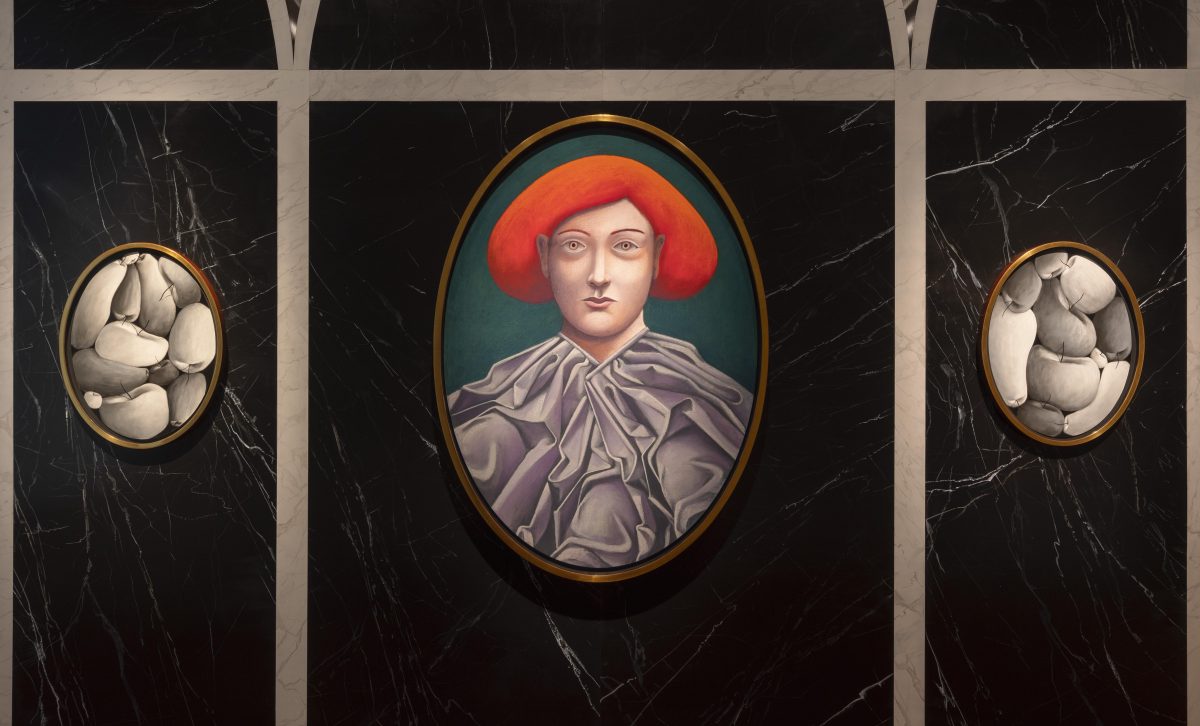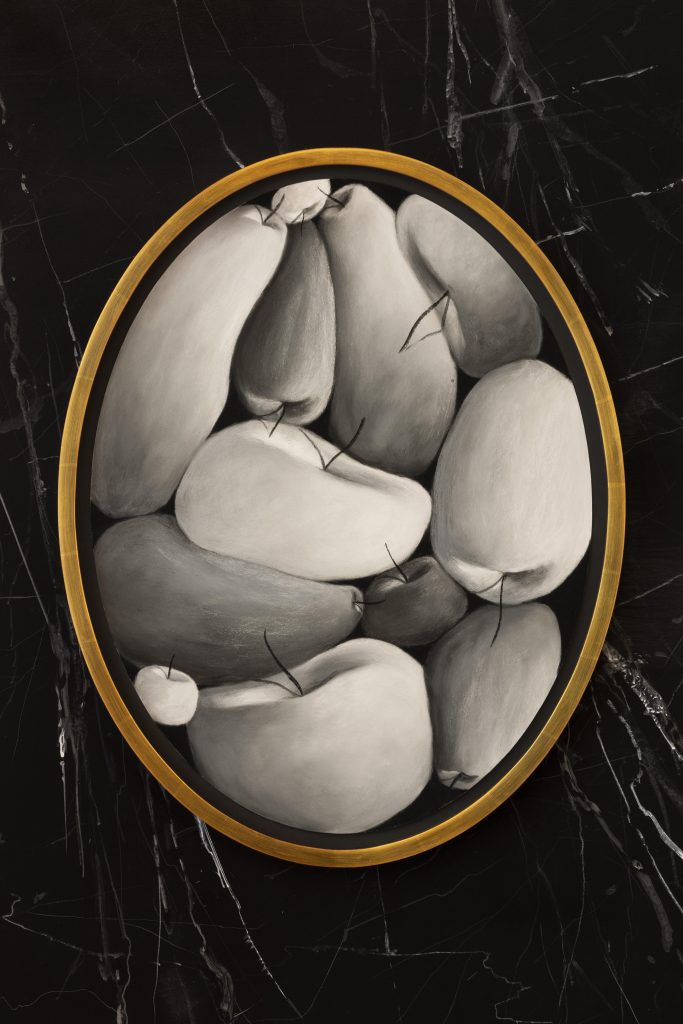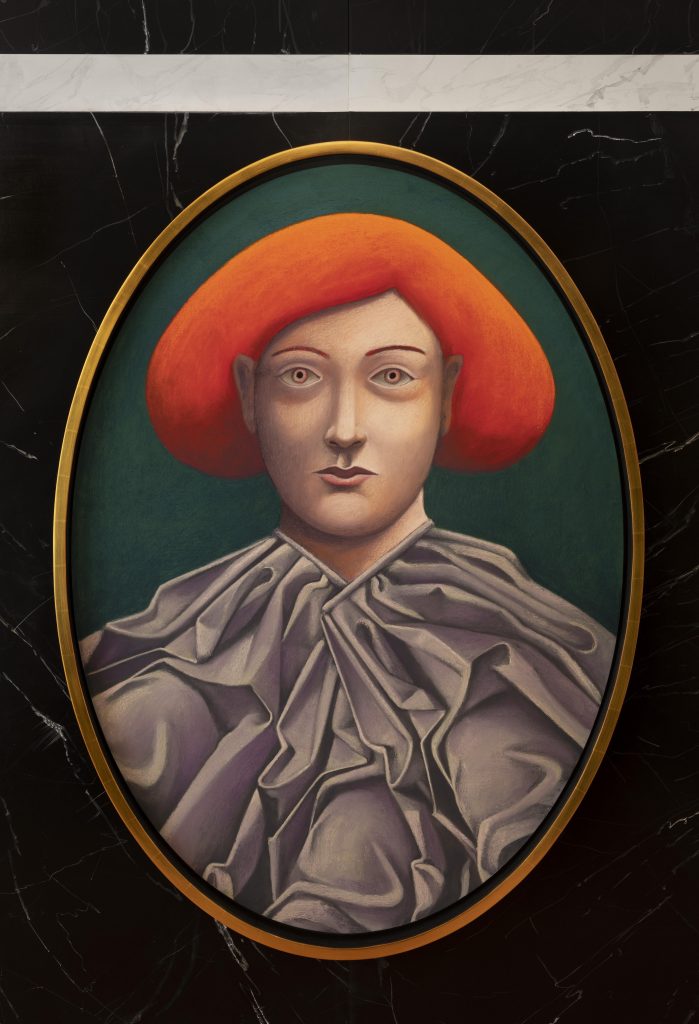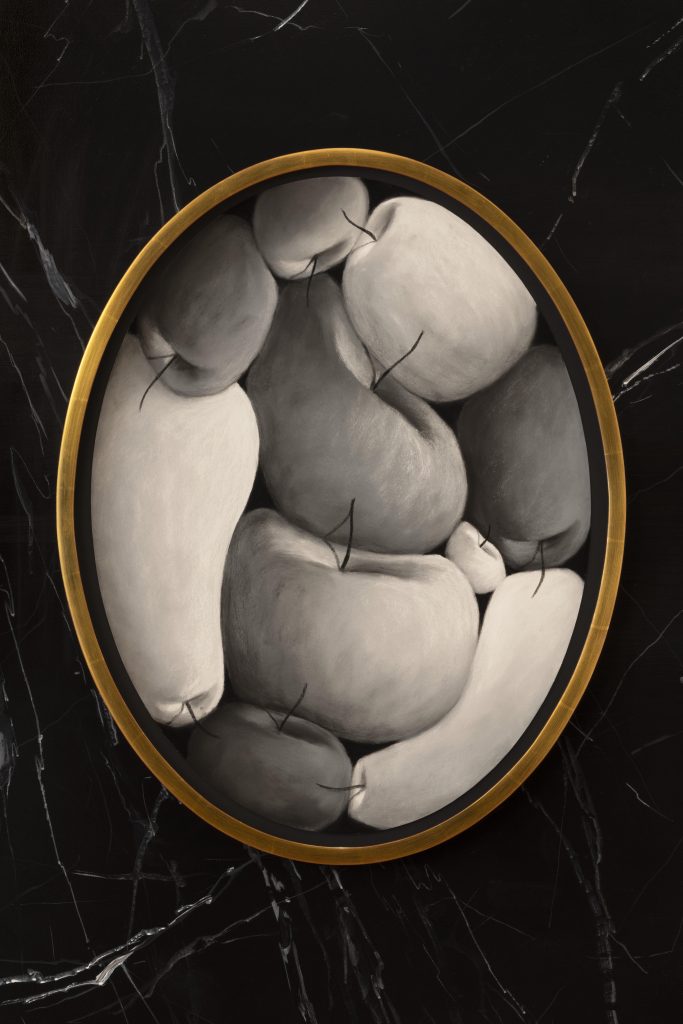
- This event has passed.
The Poldi Pezzoli Museum, following its mission to encourage the dialogue between the past and contemporary art, is pleased to present the exhibition Nicolas Party: Triptych, from April 16 to June 27, 2022 in collaboration with kaufmann repetto art gallery. For his first institutional solo show in Italy, Nicolas Party conceived a body of new works in close dialogue with masterpieces from the Poldi Pezzoli collection, opening up multiple perspectives that shed fresh light on the antique artworks as well as on the artist’s own practice.
As a leitmotif for his project, the Swiss artist has selected the triptych, inspired by Mariotto Albertinelli’s eponymous artwork in the museum’s collection. Attracted by the theatrical quality of this multi-panel object, whose wings –which by being opened or closed– hide or reveal the images painted on the inner panels, the artist establishes an unexpected juxtaposition by comparing the popular standard format of altarpieces in medieval and Renaissance art to Marcel Duchamp’s Boîte-en-Valise (the legendary avantgarde-object created by the French artist in the 1940s to contain miniature reproductions of his own artworks). The intrigued, multi-faceted interest of Party towards the triptych typology generates two different proceedings: on the one hand leading to the creation of a series of new three-dimensional works, unprecedented in the artist’s oeuvre, and on the other, to the transformation of the triptych into a monumental scenographic device for the display of new paintings.
Five free-standing triptychs by Party, preciously decorated in a faux-marble pattern, are installed upon plinths in the Salone Dorato, one of the Museum’s most famous rooms, which hosts the collection’s masterpieces including paintings by Andrea Mantegna, Sandro Botticelli, Piero del Pollaiolo, and Piero della Francesca. Party’s artworks are arranged in the center of the room. Each triptych, painted on both sides, contains a central copper panel depicting a portrait, framed by two wings depicting still lifes and landscapes, which also reappear as a dominating theme on the exterior panels, where there are executed in the grey shades of grisaille. “In the half-length portraits of the central panels of the small triptychs, Party’s personages stare out at us, as distant as icons, with their livid flesh tones and the bright tints of their clothing that have been given a sheen by the use of a copper support. (…) Characterized by free-standing arched structures and presented here for the first time, the dialogue between architecture, painting and sculpture occurs in fact within the works themselves, in continuity with the place in which they are housed, with its history and collections”, remarks Arturo Galansino in the exhibition brochure.
In the Stanza del collezionista, the triptych reappears under the guise of an imposing theatrical scenography, decorated in a severe black and white faux-marble pattern. Imitating the tripartition of the original object, but magnified and realized on a scale measuring four meters in length, the artist conceived this device for the display of new oval portraits and still lifes, realized with the technique of soft pastel. One of Party’s most distinctive features is, in fact, the use of pastel, a medium that was made popular in the 18th century by painter Rosalba Carriera, whose exquisite Ritratto di Gentiluomo is preserved in the Museum’s collection. Echoing the composition of his smaller triptychs, the two central panels of this structure each present a portrait. Here the artist makes an explicit tribute towards two of the other Renaissance paintings in the Museum’s collection, namely Bartolomeo Montagna’s Saint Paul and Saint Jerome. In this case, the curiosity of Party has been drawn wholly to the specific painterly qualities of the draped cloth that clads the two saints: “The fabric becomes an expression of the inner feelings of the character. Instead of covering the body of the saint, the fabric reveals its inner energy. There is as much expression in the fabric as there is in the faces of Saint Paul and Saint Jerome”, observes the artist. Party’s half-length portraits are hence both clad in sumptuous, richly folded cloth, each echoing the vests of one of the two saints. The reflection on Montagna’s drapery leads the artist even further, and becomes a metaphor for painting itself: “Drapery could represent the very essence of painting”, continues Party, “Before becoming a complex formation of creases and folds, the piece of fabric is flat, just like the canvas. The canvas is unpainted like a drape without folds, completely flat. It is the movement of the fabric that gives life and meaning to it, as much as paint gives meaning to a canvas.”
This exhibition continues the uninterrupted dialogue of the museum with art, from past to present, from Gian Giacomo Poldi Pezzoli’s taste to the aesthetics of a young, but already well-known contemporary artist as Nicolas Party. It is part of a series of exhibitions, started in 2011, displaying works by contemporary artists inspired by the museum’s masterpieces.
The exhibition is accompanied by an illustrated brochure with texts by Nicolas Party and Arturo Galan
Il Museo Poldi Pezzoli, nell’ambito della sua linea espositiva volta a incoraggiare il dialogo tra antico e contemporaneo, insieme alla Galleria kaufmann repetto, è lieto di presentare la mostra personale Nicolas Party: Triptych, in corso dal 16 aprile al 27 giugno 2022.
Per la sua prima mostra istituzionale in Italia, Nicolas Party ha ideato un corpus di nuove opere in stretto dialogo con i capolavori della collezione del Museo Poldi Pezzoli, aprendo molteplici prospettive che gettano nuova luce sugli antichi capolavori così come sulla sua pratica artistica.
Come leitmotif per il suo progetto, l’artista svizzero ha scelto il trittico, ispirato dall’omonima opera di Mariotto Albertinelli conservata nella collezione del Museo. Attratto dalla qualità teatrale dei pannelli che compongono l’opera, i cui sportelli – se aperti o chiusi – svelano o nascondono le immagini dipinte nei pannelli interni, l’artista crea un accostamento inaspettato paragonando il diffuso formato classico dei pezzi d’altare medievali e del Rinascimento alla Boîte-en-valise di Marcel Duchamp (leggendario oggetto di avanguardia creato dall’artista francese negli anni Quaranta per contenere riproduzioni miniaturizzate delle proprie opere). L’incuriosito e sfaccettato interesse di Party nei confronti della tipologia del trittico stimola due procedimenti differenti, portando da un lato alla creazione di una serie di nuove opere tridimensionali inedite per l’artista e, dall’altro, alla trasformazione del trittico in un monumentale apparato scenico per l’esposizione dei nuovi dipinti.
Cinque trittici autoportanti di Party, riccamente decorati con motivi faux marbre, sono installati su plinti nel Salone Dorato, una delle stanze più famose del Museo che ospita i capolavori della collezione, tra cui dipinti di Andrea Mantegna, Sandro Botticelli, Piero del Pollaiolo e Piero della Francesca. Le opere di Party sono disposte al centro della stanza. Ogni trittico, dipinto su entrambi i lati, ha un pannello centrale in rame raffigurante un ritratto affiancato da due sportelli raffiguranti nature morte e paesaggi, che ritornano anche come tematica dominante sui pannelli esterni dove sono eseguiti nelle tonalità grigie della grisaille.
“Nei ritratti a mezzobusto degli scomparti centrali dei piccoli trittici, i personaggi di Party ci fissano distanti come icone, con le carni livide e le tinte accese delle vesti che diventano smaltate per effetto del supporto in rame (…). Nei suoi Trittici, caratterizzati da strutture autoportanti centinate e presentati qui per la prima volta, il dialogo tra architettura, pittura e scultura avviene all’interno delle opere stesse, in continuità con il luogo che le ospita, la sua storia e le collezioni”, osserva Arturo Galansino nella brochure della mostra.
Nella Stanza del Collezionista, il trittico ritorna sotto le sembianze di un’imponente scenografia teatrale decorata in bianco e nero con austeri motivi faux marbre. Imitando la tripartizione dell’oggetto originale, ma ingrandendolo per una lunghezza di quattro metri, l’artista ha concepito questo dispositivo per l’esposizione di nuovi ritratti ovali e nature morte, realizzati con la tecnica del pastello morbido. Una delle caratteristiche più peculiari di Party è infatti l’uso del pastello, un medium reso celebre nel XVIII secolo dalla pittrice Rosalba Carriera, il cui raffinato Ritratto di Gentiluomo è conservato nella collezione del Museo. Riecheggiando la composizione dei suoi trittici più piccoli, i due pannelli centrali di questa struttura presentano ognuno un ritratto con cui l’artista paga un tributo esplicito a due degli altri dipinti rinascimentali presenti nella collezione del Museo, ovvero San Paolo e San Gerolamo di Bartolomeo Montagna.
In questo caso, la curiosità di Party è stata attirata dalle specifiche qualità pittoriche dei tessuti drappeggiati che vestono i due santi: “La stoffa diventa un’espressione del sentimento interiore del personaggio. Invece di coprire il corpo del Santo, ne rivela l’energia interiore. La stoffa è espressiva quanto i volti di San Paolo e di San Gerolamo”, osserva l’artista. Le figure femminili a mezzo busto dei ritratti di Party vestono quindi tessuti suntuosi e riccamente piegati, che richiamano le vesti dei due santi. La riflessione sul drappeggio di Montagna porta l’artista ancora più lontano e diventa metafora del dipinto stesso: “Il panneggio potrebbe rappresentare l’essenza della pittura”, continua Party. “Prima di piegarsi in forme complesse, il pezzo di stoffa è piatto, come la tela. La tela priva di pittura è come un panneggio senza pieghe, completamente piatto. È il movimento che dona vita alla stoffa, proprio come la pittura dà senso alla tela”.
La mostra prosegue il dialogo, mai interrotto, del Museo con l’arte, dal passato al presente, dal gusto di Gian Giacomo Poldi Pezzoli all’estetica di un giovane, ma già affermato, rappresentante dell’arte contemporanea come Nicolas Party e si inserisce in una programmazione iniziata dal 2011 di rassegne di opere di artisti contemporanei create ispirandosi ai capolavori del Museo.
La mostra è accompagnata da una brochure illustrata con contributi di Nicolas Party e Arturo Galansino.

